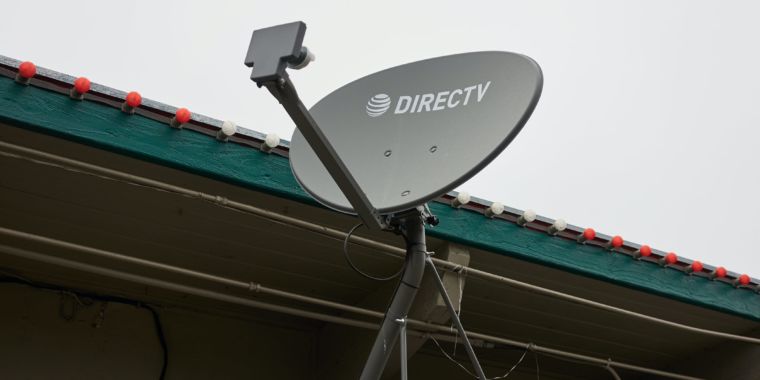

Getty Images | hapabapa
AT&T lost nearly 1 million TV customers in Q2 2020, continuing a rapid exodus of users from DirecTV and other AT&T-operated video services.
In the three months ending June 30, AT&T reported a net loss of 954,000 video customers in earnings results released today. That includes an 886,000-customer net loss from AT&T’s « Premium TV » services, a category that includes DirecTV satellite, U-verse wireline service, and the AT&T TV online service that mimics cable TV. Another 68,000 customers left AT&T TV Now, a separate streaming service formerly known as DirecTV Now.
Higher prices helped drive the customer losses. As it has in past quarters, AT&T said its practice of giving out fewer promotional-pricing deals contributed to the customer losses for AT&T TV Now. AT&T said the Premium TV loss was « due to competition as well as lower gross adds from the continued focus on adding higher-value customers. »
The latest quarterly loss left AT&T with 18.4 million video customers, including both Premium TV and AT&T TV Now, down from nearly 25.5 million in mid-2018.
About 91,000 customers who are counted among the net TV losses actually still had service as of June 30. These are subscribers « for whom we have agreed not to terminate service under the FCC’s ‘Keep Americans Connected Pledge,' » AT&T said. « For reporting purposes, the company counts these subscribers as if they had disconnected service. »
That FCC pledge was implemented in response to the coronavirus pandemic but expired on June 30, so those customers could get disconnected for real if they don’t pay back what they owe. The pledge technically only covered broadband and phone service, but AT&T’s statement indicates the company also applied it to TV customers or at least to customers who bundled TV with phone or broadband.
HBO Max has 4 million subscribers
AT&T is trying to revive its video fortunes with HBO Max, a result of its acquisition of Time Warner Inc. However, AT&T said HBO revenue in Q2 was « $1.6 billion, down 5.2 percent year over year, reflecting a decrease in subscription revenues and content and other revenues. » HBO operating expenses were « $1.5 billion, up 32.5 percent year over year, primarily due to higher programming costs and expenses related to HBO Max, » AT&T said.
HBO Max launched in May and has 4 million customers, including « roughly three million retail customers, and an additional million activations that came through AT&T platforms (i.e., bundled plans, » The Verge wrote today.
« Through cable customers and HBO Now subscribers, the company already had more than 30 million subscribers it could move over to HBO Max, » The Verge wrote. « [AT&T CEO John] Stankey noted [in an earnings call today] that getting people subscribed to HBO through traditional linear cable packages to sign up for HBO Max has been slow, and that’s an area they want to focus on improving. »
At $15 a month, HBO Max provides just a fraction of the per-customer revenue that AT&T gets from satellite and cable-like services. AT&T’s average revenue per user for Premium TV is $124.98 a month. That’s up from $112.19 in mid-2018, reflecting AT&T’s price hikes and reduced use of promotions.
AT&T also lost some broadband customers last quarter, dropping from 14.05 million to 13.94 million. Fiber customers rose from 4.1 million to 4.32 million during the three-month period, but losses in the DSL category brought the total number of customers down. Average revenue per user in broadband was $51.61 a month.
Pandemic’s hit on revenue
Companywide, AT&T operating revenue dropped from $44.96 billion in Q2 2019 to $40.95 billion in Q2 2020. Net income dropped from $3.97 billion to $1.56 billion.
The pandemic affected AT&T results. AT&T estimated a $2.8 billion impact from the pandemic on revenue in Q2 alongside a $510 million impact on EBITDA (earnings before interest, taxes, depreciation, and amortization). AT&T said this was due to:
[T]he following COVID-19 related pressures: (1) the cancellation and postponement of televised sporting events, resulting in lower advertising revenues and associated expenses, (2) the closure of movie theaters and postponement of theatrical releases, leading to lower content revenues and associated expenses, (3) the imposition of travel restrictions, driving significantly lower international wireless roaming services that do not have a directly correlated expense reduction and most significantly impact profitability, (4) closures of retail stores, contributing to lower wireless equipment sales, with a corresponding reduction in equipment expense and (5) unfavorable foreign exchange pressure in Latin America.
AT&T said its EBITDA took another $320 million hit from the pandemic in « incremental costs associated with voluntary corporate actions taken primarily to protect and compensate front-line employees and contractors, and WarnerMedia production disruption costs. »

